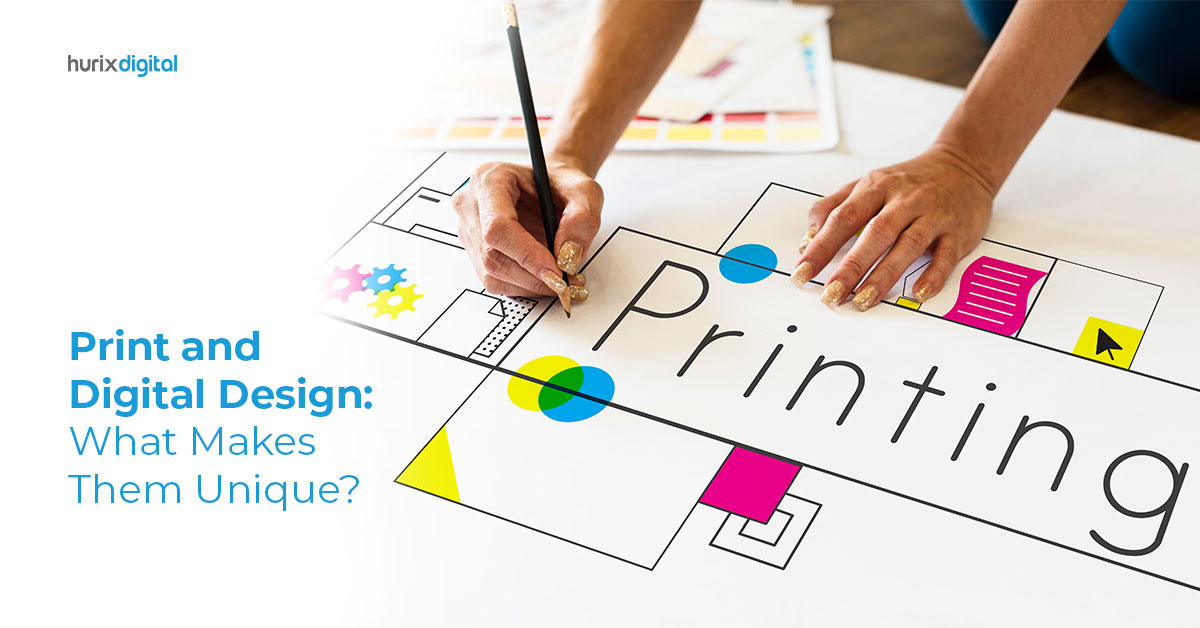
Print and Digital Design: What Makes Them Unique?
Summarize with:
With screens now the norm, the boundary between print and digital design has disappeared. Both share the singular aim of reaching people through effective communication; however, the challenges and opportunities have been transformed in recent years.
An outlet is being created for millions of designers in an increasingly sophisticated landscape- the room for digital advertising; such investments are predicted to reach $965.6 billion in 2028.
Thus, obsolete print design, which once was a keystone of marketing, is combined with ever-changing digital experiences.
We will study the distinct elements of print and digital design and observe the driving motives of the marks of distinction and the strategies undertaken for longevity in the new age.
Table of Contents:
- Key Differences Between Print and Digital Design
- What is Print Design?
- What is Digital Design?
- Graphic Design Print
- Difference Between Digital Art and Graphic Design
- Print Design vs Digital Design
- Conclusion
- Frequently Asked Questions (FAQs)
Key Differences Between Print and Digital Design
Print and digital design differ in several ways, but they also share some similarities. The two disciplines require different skill sets and approaches due to the unique characteristics of the mediums, the intended audiences, and the final outputs.
Here are some key differences between print and digital design:
- Medium: Print design is created for physical, printed materials such as books, magazines, brochures, and posters, while digital design is created for electronic media such as websites, mobile apps, and social media platforms.
- Design Process: Print design often requires a more meticulous design process, including careful consideration of printing processes, paper stock, and other physical factors affecting the final product. Digital design, on the other hand, is often more flexible and allows for faster iteration and testing.
- Intended Audience: Print design is often targeted toward an older, more traditional audience, while digital design is often targeted toward a younger, more tech-savvy audience.
- Typography: Typography plays a critical role in print design since printed materials need to be legible at different sizes and from various distances. Typography is also important in digital design, but designers often have more flexibility because viewers can easily zoom in or out of digital content.
- Output: Print design requires high-resolution, high-quality output that can be physically held and viewed from different angles and distances. Digital design output can vary depending on the device, screen size, and resolution.
- Interactivity: Digital design often allows for interactivity, such as clickable buttons, scrolling features, and animations, while the print design is generally static.
Also Read: Tips And Best Practices For Converting Content Formats From Print To Digital
What is Print Design?
In the domestic domain, where one can paint every color on the computer, there are shades of color where printing is not absent. Nowadays, everything is a blueprint, cut imperiously, and fits pleasing patterns. And books and magazines designed for our culture are at the core of all these manipulations.
Print designers use Adobe Illustrator, Photoshop, InDesign, or Auxo software to create printable graphical images for prints. They also have to consider the output print’s circumference, resolution, and color mode, as well as the kind of paper or surface to be used.
Apart from the aesthetic aspect of the prints, the print designers have to ensure that the prints communicate the purpose for which they are designed well to the target market. This might require some understanding of typography, layout design, color theory, and principles of design, among other aspects of the design that help to make the design well-integrated and user-attractive.
To sum up, print design requires technical expertise, design skills, and creative design skills to successfully complete a design that will look good and carry out its purpose as intended. As much as digital media has contributed to the redefinition of the practice of print design, it is still a very relevant and powerful visual communication mode.
What is Digital Design?
Digital design creates visual content and user experiences using digital tools and technologies. It encompasses various design disciplines, including web design, graphic design, UI/UX design, and motion graphics.
Digital design includes designing anything through Adobe Photoshop, Illustrator, Sketch, and Figma. This includes coding with HTML, CSS, and JavaScript. Other technologies, like virtual and augmented reality or artificial intelligence and machine learning, may also be adopted.
Digital designers also create images for electronic devices, including computers, mobile phones, and tablets. Depending on the particular device or platform, these create an attractive and functional experience.
Thus, digital design is still and will remain a critical practice today, as it seems most people have turned to digital devices for accessing and interacting with information. It is very important, from design principles employed in constructing websites to regulating graphics on mobile applications.
Graphic Design Print
Simply put, graphic print design is the art and science used to create designs to print them on various physical surfaces and materials. It includes designing business cards, flyers, and other items, billboards, and packaging designs.
Print graphic designers usually work with Adobe Illustrator, Photoshop, InDesign, and similar programs to prepare print-ready optimized outputs. The factors that influence the format include the size, resolution, and color mode of the output, the type of print media, and the printing surface that will be used.
For example, someone who works in print may also have to communicate with printing specialists to ensure that the product will be printed correctly and with adequate quality according to the given specifications. They should know various printers and many ways to apply them, such as controlling when to use offset printing, digital printing, or screen printing, and the respective measures to take for their designs.
Apart from creating pleasing designs, graphic designers for print must ensure that the presented designs carry the right message. To this end, they may analyze typography, layout, color, and other design components to create a visually relevant design.
Difference Between Digital Art and Graphic Design
Digital art and printing art are two different types of art with distinct characteristics and processes involved.
Computers and smart gadgets support a novel form of creativity called digital arts. In digital art, different methods, such as drawing, painting, and photography, among other usual art forms, are incorporated. The artist draws the image with a special pen or stylus to create a digital work of art, which can be stored in several file types, including, but not limited to, JPEG, PNG, and PSD.
One of the main characteristics of digital art is its ease of modification and reproduction, which makes it desirable for commercial purposes like advertising and graphic design, among others.
Printed art, on the contrary, implies the art of placing or imaging an artwork onto physical surfaces such as paper and canvas through the employment of various printing techniques, e.g., screen printing, lithography, etching, etc.
Networked journalism often implies using the Internet to design a storyboard and involve multiple visual elements to aid the key message. In this case, preachy is not curtailed in time propagation to promote and raise customer awareness.
Print Design vs Digital Design
In print design, the primary focus is on creating tangible printed artifacts, such as on surfaces made of paper, fabric, or plastic—materials pertained by print design printing canvases, business cards and leaflets, packaging, and posters.
Print designers must consider the means, color, typography, and arrangement to ensure that the final product is attractive and capable of relaying the intended message. In addition, they should understand printing processes and outcomes such as color matching and resolution so that the printed work comes out as designed.
In contrast, digital design emphasizes creating materials that target screens only, like software, websites, mobile applications, and digital marketing.
When creating screen content today, digital designers must consider screen resolution, color calibration, user interaction and behavior, and responsiveness. They usually collaborate with web development teams to ensure that their designs are practical and that users do not face difficulty when using different gadgets and platforms.
Conclusion
To summarize, print and digital designs have peculiarities that differentiate them. Print design creates a physical and tangible experience, whereas digital design creates an interactive and kinetic experience. Recognizing the merits of each medium, designers can generate target experiences that are meaningful and satisfying to the users and address their particular needs and wants.
At Hurix Digital, we develop e-learning content and provide publishing services and digital marketing services.
We also aim to incorporate current trends and advancements in the print industry by training all relevant personnel on the current versions and features of InDesign. This is important because it helps us tap the software’s entire capabilities to assist us in delivering digital design, print design, and layout design, among other typesetting services, to our clients.
Get in touch with us to know more.
Frequently Asked Questions (FAQs)
Q1. What is the most fundamental difference between print and digital design?
The major difference between print and digital design is the medium and how the content is delivered. Print design is printed and distributed physically through brochures, hoardings, etc. Digital design, in contrast, is viewed on a screen.
Q2. Which of the two is more challenging between print and digital design?
Both print and digital design can be challenging. Some of the challenges for print design are size, space, color management, precision, manufacturing costs, and prepress steps. In contrast, digital design demands resolution, interactivity, flexibility, multimedia elements, etc.
Q3. Can the same skills in print design be applied to digital design?
Yes, you can apply the same skills in print design to digital design. This includes visual communication, designing, interactivity, and tools like Adobe Illustrator, Photoshop, and Canva.
Q4. Does print design have any place in this digital world?
Yes, print design has a significant role in the digital world. It offers tangible, high-quality experiences that digital design fails to replicate. Moreover, it strengthens brand identity, improves marketing efforts, and adds value to publications, events, etc., complementing digital strategies.
Q5. What is the most popular application for print and digital design?
For print design, consider tools like Adobe InDesign, Adobe Illustrator, and Adobe Photoshop; for digital design, consider Adobe XD, Figma, Sketch, and Photoshop.
Summarize with:

Ramprasath is the Project Manager – Operations (HPT-DCT). He is post graduate in computer science and has 8+ years of experience in Project Management and 18+ years of experience in Graphics Designing, Client Management, Resource Management, and managing the Offshore Books and Journals typesetting team. He is proficient in Adobe Creative Suite software, has knowledge of typography and color theory, and has expertise in E2E Project management services for Books and Journals.
 A Space for Thoughtful
A Space for Thoughtful 